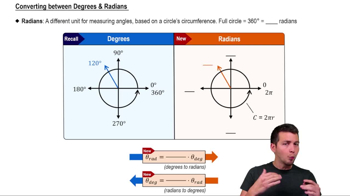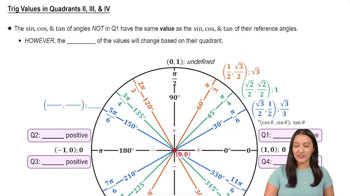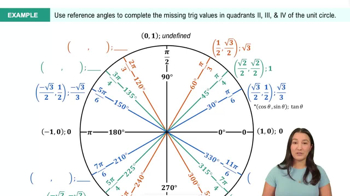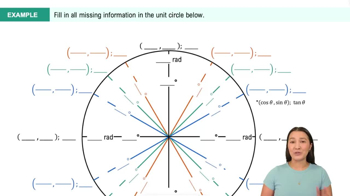Table of contents
- 0. Functions7h 52m
- Introduction to Functions16m
- Piecewise Functions10m
- Properties of Functions9m
- Common Functions1h 8m
- Transformations5m
- Combining Functions27m
- Exponent rules32m
- Exponential Functions28m
- Logarithmic Functions24m
- Properties of Logarithms34m
- Exponential & Logarithmic Equations35m
- Introduction to Trigonometric Functions38m
- Graphs of Trigonometric Functions44m
- Trigonometric Identities47m
- Inverse Trigonometric Functions48m
- 1. Limits and Continuity2h 2m
- 2. Intro to Derivatives1h 33m
- 3. Techniques of Differentiation3h 18m
- 4. Applications of Derivatives2h 38m
- 5. Graphical Applications of Derivatives6h 2m
- 6. Derivatives of Inverse, Exponential, & Logarithmic Functions2h 37m
- 7. Antiderivatives & Indefinite Integrals1h 26m
- 8. Definite Integrals4h 44m
- 9. Graphical Applications of Integrals2h 27m
- 10. Physics Applications of Integrals 2h 22m
0. Functions
Introduction to Trigonometric Functions
Problem 1.4
Textbook Question
A hot-air balloon rising straight up from a level field is tracked by a range finder located 500 ft from the point of liftoff. Express the balloon’s height as a function of the angle the line from the range finder to the balloon makes with the ground.
 Verified step by step guidance
Verified step by step guidance1
Consider the right triangle formed by the balloon, the range finder, and the point on the ground directly below the balloon. The balloon's height is the opposite side, the distance from the range finder to the point of liftoff is the adjacent side, and the line from the range finder to the balloon is the hypotenuse.
Let \( \theta \) be the angle between the ground and the line from the range finder to the balloon. We need to express the balloon's height \( h \) as a function of \( \theta \).
Use the tangent function, which relates the opposite side to the adjacent side in a right triangle: \( \tan(\theta) = \frac{\text{opposite}}{\text{adjacent}} = \frac{h}{500} \).
Solve for \( h \) in terms of \( \theta \): \( h = 500 \cdot \tan(\theta) \).
Thus, the balloon's height as a function of the angle \( \theta \) is \( h(\theta) = 500 \cdot \tan(\theta) \).
 Verified video answer for a similar problem:
Verified video answer for a similar problem:This video solution was recommended by our tutors as helpful for the problem above
Video duration:
3mPlay a video:
Was this helpful?
Key Concepts
Here are the essential concepts you must grasp in order to answer the question correctly.
Trigonometric Functions
Trigonometric functions, such as sine, cosine, and tangent, relate the angles of a triangle to the lengths of its sides. In this context, the height of the balloon can be expressed using the tangent function, which connects the angle of elevation from the range finder to the height of the balloon and the horizontal distance from the range finder to the point of liftoff.
Recommended video:
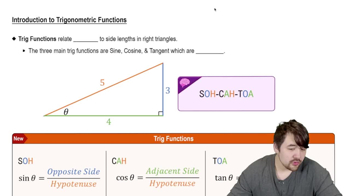
Introduction to Trigonometric Functions
Right Triangle Relationships
The scenario involves a right triangle formed by the height of the balloon, the horizontal distance from the range finder to the liftoff point, and the line of sight to the balloon. Understanding the properties of right triangles is essential for applying trigonometric ratios to find the height of the balloon as a function of the angle of elevation.
Recommended video:

Estimating the Area Under a Curve with Right Endpoints & Midpoint
Function Representation
In calculus, expressing one quantity as a function of another is fundamental. Here, the height of the balloon is represented as a function of the angle of elevation, allowing for the analysis of how changes in the angle affect the height. This relationship can be modeled mathematically, facilitating further exploration of the balloon's motion.
Recommended video:

Properties of Functions

 5:4m
5:4mWatch next
Master Converting between Degrees & Radians with a bite sized video explanation from Patrick Ford
Start learning
